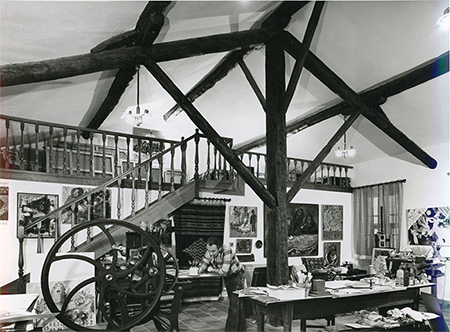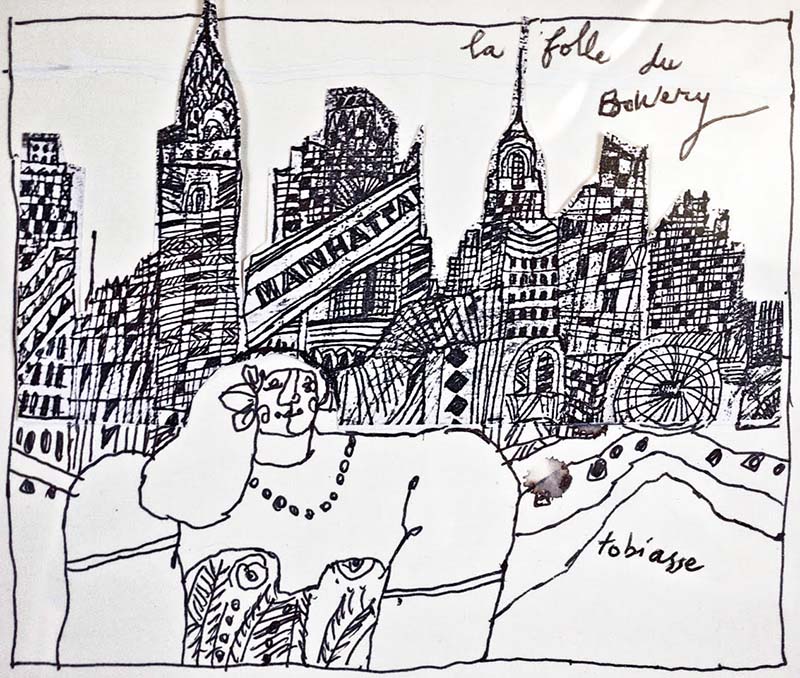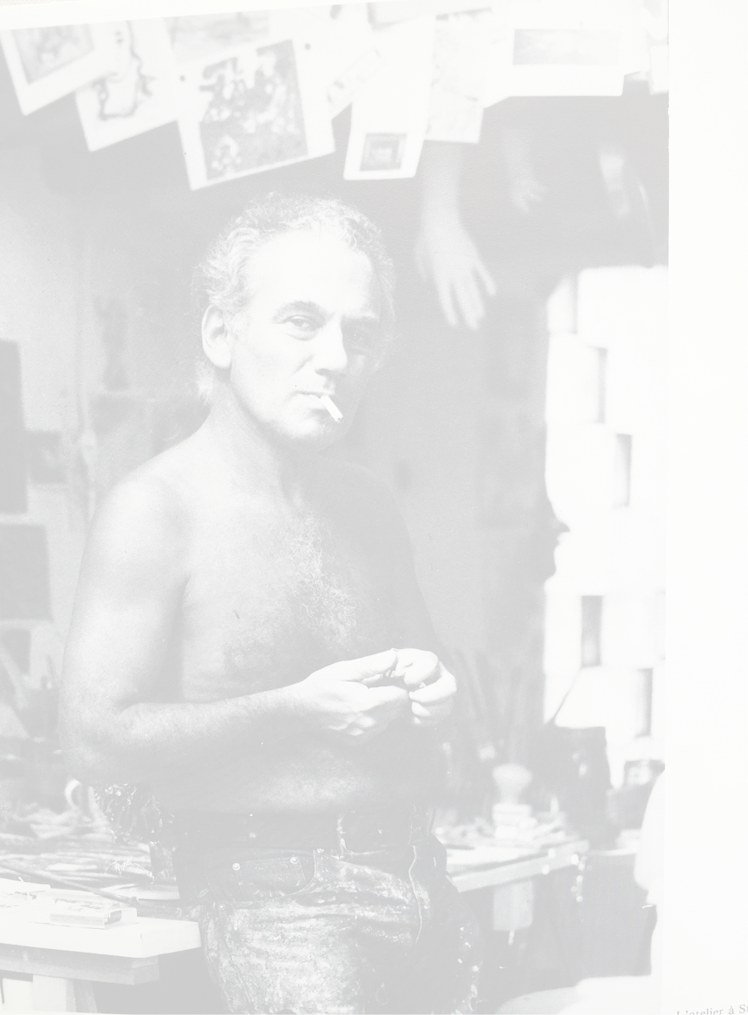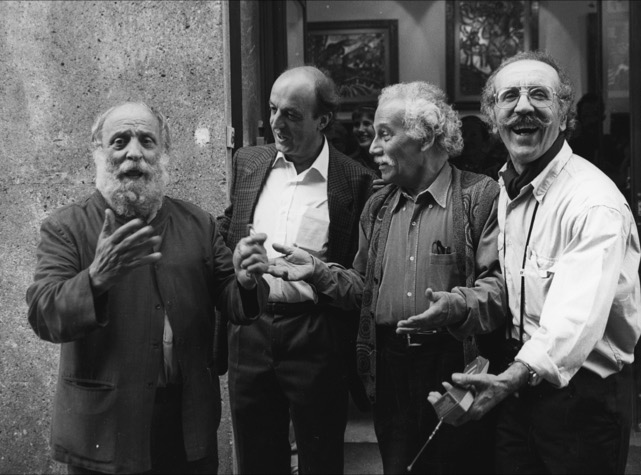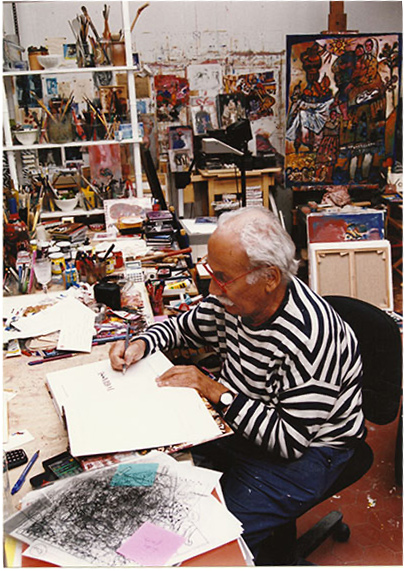Fêtes Juives et une fresque, Que tes tentes sont belles, ô Jacob (1982), the Nice Jewish Community Centre (Michelet).
Les Trains de terreur des bords de la folie (1983), oil on canvas, the Simon Wiesenthal Center, Los Angeles, the United States.
Sarah portant Isaac, retour du Mont-Moriah (1984), oil on canvas, the Museum of Modern and Contemporary Art in Nice.
La Liberté éclairant Saint-Paul-de-Vence and La Liberté éclairant les enfants de l’exil (1987), mixed techniques on panels of wood laminate, each panel 400 × 290 cm, Nice Convention Centre, France.
Musée Tobiasse – Chapelle Saint-Sauveur (1989), showcasing of the Saint-Sauveur Chapel on the theme “Life is a celebration”, comprising an interior wall mural, stained glass windows, an outside mosaic on the façade and a polychrome sculpture on the forecourt Oiseau de lumière, Le Cannet, France.
The scenery and costumes for Pygmalion (1992) by George Bernard Shaw, for the Arketal Company, within the framework of the International puppet festival, Cannes, France.
Le Chant des prophètes (1993), stained glass windows in the Great Synagogue of Nice, France.
Venus de Saint-Paul de Vence (2008), bronze sculpture, Saint-Paul de Vence, France.
Albert Memmi, Le Miraculé: Important Works, Steensen, Oslo, 1984.
Chaïm Potok, Théo Tobiasse: Artist in Exile, Rizzoli, New York, 1986.
Sylvie Forestier, Tobiasse: le radeau des cantiques, Librairie Séguier and Vision Nouvelle, 1991.
Raoul Mille, Théo Tobiasse: Regards secrets, Retrospective Catalogue, Cagnes-sur-Mer Castle Museum, 1992.
Gérard de Cortanze, Tobiasse: ou le patient labyrinthe des forme, La Différence, in the collection « Mains et Merveilles », 1992.
Aux franges de l’éveil
Work illustrated by six lithographs. Six poems by M.A. Courouble. Pierre Chave, Vence, 1987.
Gouttes d’ombre sur la peau des jours
Work illustrated by six etchings. Text by Guy Marester. Pierre Chave, Vence, 1988.
La fête de Riwka
Work illustrated by twenty lithographs, each unique, having all been printed in different colours. Text by J. Thuillier. Pierre Chave, Vence, 1989.
Errances et désirs au temps du Sinaï
Work illustrated by three 17 x 98 cm folded and concertinaed intaglio engravings and etchings. Text by Marek Halser. Robert et Lydie Dutrou, 1990.
L’amour couleur de psaumes
Work illustrated by two 14 x 83.5 cm folded and concertinaed intaglio engravings and etchings. Text by Raoul Mille. Robert et Lydie Dutrou, Paris, 1991.
Artistes, muses et volupté
Work illustrated by eight original lithographs in a box containing a Sketchbook-Diary, « dessins et écrits » by the Artist. Edition de la Différence, Paris, 1992.
C’était il y a 500 ans…
Work created for the five hundredth anniversary of the Spanish expulsion of the Jews. Presented in a canvas portfolio, containing six original lithographs with a text in Hebrew taken from Exodus, told by Haïm Vidal-Sephira. La Diagonale de l’Art, Paris, 1992.
Entre Myrte et Fleur de Cannelle
Album containing seven original lithographs with a text by the Artist. Editions de la Différence, Paris, 1992.
Aux confins de tous les désirs
Work illustrated by seven original lithographs with a text by the Artist, all inside a canvas-covered cardboard insert. Editions de la Différence, Paris, 1995.
Un chant d’exil et de lumière
Album containing six original lithographs with a text by the Artist. Klim Art Publisher, Toronto, Canada, 1997.
50 printemps pour Israël de toutes les lumières
Album containing seven original lithographs with a text by the Artist. Klim Art Publisher, Toronto, Canada, 1999.
Théo Tobiasse, Les Venise de Tobiasse, éditions de la Différence, Paris, 1992 (ISBN978-2729107925).
Théo Tobiasse, Dessins et Ecrits, éditions de la Différence, 1992 (ISBN2-7291-0791-6).
Théo Tobiasse, Saint-Paul-de-Vence et autres rivages: Journal Tobiasse 1984/1992, éditions de la Différence, Paris, 1994 (ISBN2-7291-1045-3).
Théo Tobiasse, Les Carnets de Saint-Paul-de-Vence, 1993-2001, éditions Biro, Paris, 2007.
Josy Eisenberg, Dis-moi qui tu peins, TF1, 1977.
Patrick Visionneau, L’Atelier de Tobiasse, FR3 Côte d’Azur, 1988.
Laurence Badon, La Traversé du désir, FR3 Côte d’Azur, Magazine des Arts, 1988.
Dominik Rimbault, La vie est une fête, Dominik Rimbault et le CNAP, 1989.
Jacques Renoir, Tobiasse, Encore un fleuve à traverser, Anna Productions, 1990.
Georges Bégou, Rétrospective Tobiasse, Antenne 2, (1992).
Laurence Badon, Tobiasse se penche sur 35 ans de création, FR3 Côte d’Azur, Magazine culturel, 1992.
Dominik Rimbault, Mémoire gravée dans la couleur du temps, Dominik Rimbault et le CNAP, 2001.









